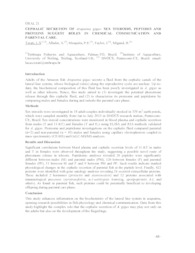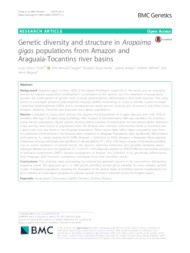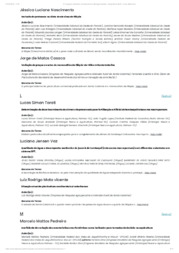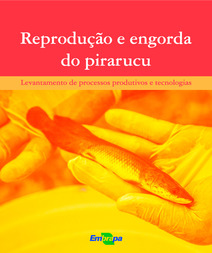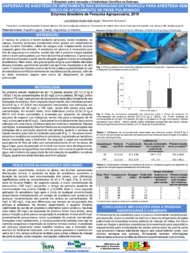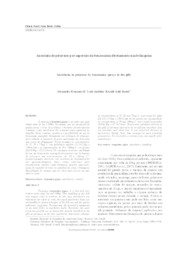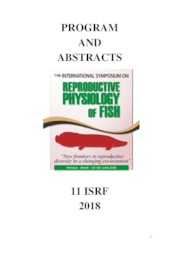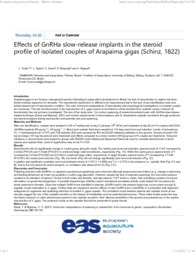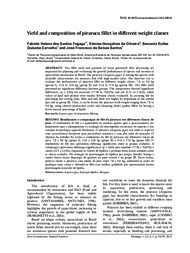Search Publications
Filter by:
| Author(s): TORATI, L. S.; ALBALAT, A.; MESQUITA, P. E.; TAYLOR, J.; MIGAUD, H. Adults of the Amazon fish Arapaima gigas secrete a fluid from the cephalic canals of the lateral line system, whose biological role(s) along the reproductive cycle are unclear. Up-todate, the biochemi... ... |
| Author(s): TORATI, L. S.; TAGGART, J. B.; VARELA, E. S.; ARARIPE, J.; WEHNER, S.; MIGAUD, H. Background: Arapaima gigas (Schinz, 1822) is the largest freshwater scaled fish in the world, and an emerging species for tropical aquaculture development. Conservation of the species, and the expansi... ... |
| Author(s): PEDREIRA, M. M.; PEREIRA, A. S.; LIMA, A. F.; SILVA, D. S.; ANDRADE, M. C. de Objetivou-se com esse trabalho avaliar o coeficiente de variação como balizador para tomadas de decisão para a classificação de juvenis de pirarucú ao longo do cultivo em sistema intensivo com recircu... ... |
| Author(s): REBELATTO JUNIOR, I. A.; LIMA, A. F.; RODRIGUES, A. P. O.; MACIEL, P. O.; KATO, H. C. de A.; MATAVELI, M.; REZENDE, F. P.; VARELA, E. S.; SOUSA, A. R. B. de; SANTOS, C.; BOIJINK, C. de L.; YOSHIOKA, E. T. O.; O'SULLIVAN, F. L. de A. Dados gerais das pisciculturas de reprodução e engorda. Propriedades de reprodução: número médio de reprodutores e idade; origem dos reprodutores por bacias hidrográficas; estruturas de cultivo, densi... ... |
| Author(s): INOUE, L. A. K. A.; HONCZARYK, A. Este trabalho avaliou de forma prática a possibilidade do uso de anestésicos borrifados diretamente nas brânquias do pirarucu, a fim de se obter anestesia segura sem riscos de afogamento do peixe pulm... ... |
| Author(s): HONCZARYK, A.; INOUE, L. A. K. A. O pirarucu (Arapaima gigas) é um peixe que pode atingir mais de 2m e 100kg. No entanto, por ser um animal de grande porte, o risco de acidentes é bastante elevado durante o manejo. Logo, anestésicos s... ... |
| Author(s): AMARAL, A.; MAZZONI, T. S.; ALMEIDA, F. L. The pirarucu (Arapaima gigas) are the biggest scale Amazonian fish and their farming potential is enormous. However, there are few studies involving the reproductive physiology of pirarucu. Raising fi... ... |
| Author(s): TORATI, L.; TAYLOR, J.; MESQUITA, P.; MIGAUD, H. The aim of the study were 1) to induce spawning of isolated broodstock pairs with GnRHa slow-release implant technique (Zohar and Mylonas, 2001) and monitor steroid levels in blood plasma; and 2) char... ... |
| Author(s): FOGACA, F. H. dos S.; OLIVEIRA, E. G. de; CARVALHO, S. E. Q.; SANTOS, J. F. de S. The fillet yield and quantity of waste generated after processing are important for planning and evaluating the growth performance of species and systems of aquaculture production in Brazil. The pirar... ... |
| Author(s): ADOLFI, M. C.; DU, K.; KNEITZ, S.; CABAU, C.; ZAHM, M.; KLOPP, C.; FERON, R.; PAIXÃO, R. V.; VARELA, E. S.; O'SULLIVAN, F. L. A.; OLIVEIRA, M. A. de; NÓBREGA, R. H.; LOPEZ-ROQUES, C.; IAMPIETRO, C.; LLUCH, J.; KLOAS, W.; WUERTZ, S.; SCHAEFER, F.; STÖCK, M.; GUIGUEN, Y.; SCHARTL, M. Our study broadens our current understanding about the evolution of sex determination genetic networks and provide a tool for improving arapaima aquaculture for commercial and conservation purposes. |
Observation
Some of Embrapa's publications are published as ePub files. To read them, use or download one of the following free software options to your computer or mobile device. Android: Google Play Books; IOS: iBooks; Windows and Linux: Calibre.
Access other publications
Access the Agricultural Research Database (BDPA) to consult Embrapa's full library collection and records.
Visit Embrapa Bookstore to purchase books and other publications sold by Embrapa.

